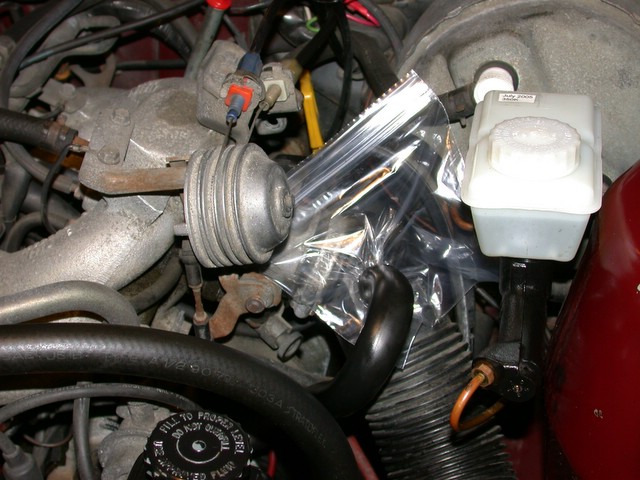|
Hi,
I Been reading over the posts and in my personal opinion the engine cannot run faster than the amount of air it can get into it.
Art Benstein, had you plug off the line to closed that avenue from the engine getting some air it shouldn’t be from the IAC.
The other side of the IAC has a hose that goes directly into the intake. Make sure that hose has no cracks or splits. It need to seal tightly even if you have to put a screw clamp on the manifold side. It’s a large port and that in itself gives it strength to suck volumes of air, so that why its got the IAC in it!
Three places are left for air entry. Those small vacuum hoses are always possible but I’m sure you can search those out. There are only a few but a split usually shows up on the underside to be missed. You got to look them over, almost, like you were going to lick them next! (-:)
The large vacuum hose going over to the vacuum brake booster or its internal diaphragm.
Once it empties the booster, it holds a vacuum.
Check the check valve for crack or failure to hold a vacuum over the diaphragm.
Just after a shut down you can wiggle the valve in the grommet, some, if it’s too soft consider replace the grommet. You want to listen for a hiss as air goes in. If you take it out, the air it only flows one way.
This next one is easily overlooked and it’s a plain ole’ stop screw.
It’s located under a lever attached on the throttle plate shaft on the opposite side from the throttle position switch.
If it becomes overly adjusted upwards, it hold the throttle plate open just a crack, but it’s all the away around that large plate! Imagine it compared to the diameter of the IAC port tube?
Even if it was closed absolutely tight in the bore by spring pressure, and it is, you can still pour water through it. Just Imagine some thin air flowing by it!
You got to make sure that the stop is completely backed off and look inside at the bore for a nice completely encircled plate with outer housing!
The stop screw is then set up to just to touch that lever. And then only enough more of a turn to take up some spring pressure but not move that plate open!
The screw is there only as a safety measure. To make sure it will not get stuck or frozen in the aluminum bore since it’s a soft thin plate.
This turn amounts to about 1/8 of a turn or about the width of the slot in the head of the screw.
Now that you get that set, there is no other way for air to get in. This is below or at the bottom of the flow range of the IAC. The engine should not run very fast or even be considered in an idle speed.
This was where the “old” black knob comes in. It’s deleted on later cars.
It allowed you to to keep the engine at a limp (500-600 rpm) idle, while the wire you talk about trying to use, is grounded, to shut down the IAC! Usually two ways to do a task. There is the German way, technically sophisticated ... Or you use the plastic bag trick, that mechanically way to truly rule out a stuck/bad or sticking IAC, that maybe complicating things!
That screw gets messed with more for a temporary issue of the engine dying from a too lean condition. Usually when coming to a stop it seems?
That screw can mess with the throttle switch communication setting that screws with the ECU for knowing when to idle or not to idle when the plate moves. The ECU needs just a little heads up to know that the air flow is changing towards a power need. It helps to be already going into the power up mode! It makes for better transitions in both directions!
They wouldn’t put a switch on there if there was not a lag and need, as they cost money!
Lean conditions can be blame on the accordion hose for having a leak that upsets mixtures and air flow calculations that were given by the AMM. The ECU works with the AMM and the Oxygen sensor but working and fighting changes beyond its knowledge with only the IAC, injectors pluses and timing mentioned by Art Benstein. The starting point for advancement is somewhat important.
Later, LH cars got the CPS that removed another “tinker” point!
Here, is when it all gets crappy over milliseconds, that get longer with more erratic issues until a little human, with tweaking fingers, shows up with a handy dandy screwdriver.
Yep, Its appropriately named for the job, as it screws everything over it touches, like stop screws!
You know, it’s about the only adjustment left in the LH system after the black knobs disappeared.
This is why I give the LH a lot of credence as these cars are coming down the pike of many previous owners or fly by night knuckle busters messing with the throttle plate to work around other faults.
So after all of this, look into stopping all the air! Only allowing it to have what it can handle, while using a good ignition system, the other problems will raise their ugly heads in a more orderly sequence.
These cars are not a wack-a-mole game but only the opposite, as they are very predictable, meaning after all these years on the road.
I’ll keep watching from over the fence, showing only my eyes, reading the next posts and like a good neighbor, Smiling!
Phil
|


